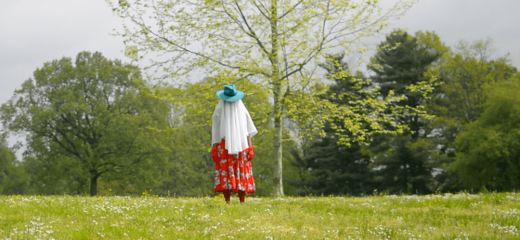
Finding Breath in Our Altars: Reviving Black Bodies
by L. Graciella Maiolatesi
Breathe In. Breathe Out.
As you read this, remember to check in with your breath, the rise and fall of your chest, the awakening of worlds in you.
Breathe In. Breathe Out.
This is the directive the audience receives from dance scholar, practitioner, and Artistic Director of FLYGROUND, Dr. Lela Aisha Jones, as she presents her latest embodied research, “Diasporic Movement Practices: Activism, Integrity, Revivals: Breath,” at the Temple University Dance Colloquium Series. I attend this evening’s colloquium out of the deepest respect for Jones’s research: she has served as an external mentor throughout my Dance MFA journey at Temple University. Jones’s interactive movement-lecture explores collective breath, and uses breath to situate Black bodies in the current political climate. Jones affirms that she doesn’t “know how just yet, but [that] the pedagogies of breath are imbedded in the African Diaspora.” Jones continues, referencing scholarly sources Blackpentecostal Breath and In the Wake of Blackness and Being to further support her claim. Later in informal conversation she adds Emergent Strategy—my current activist/artistic/personal bible—as another source she is beginning to include in her research.
Jones instructs us in the audience to find a partner, place our hands on their backs, and in locating their breath, allow ourselves to sync with their breathing:
Breathe in. Breathe out.
I feel warm hands on my shoulder blades, hands that belong to a dear friend; my hands connect to the back of a stranger, yet through our shared inhalations I feel as if I have known them for years. My breath softens, deepens, and the hands on my scapula become ancestral. A reminder that we stand on our ancestor’s shoulders.
Breathe In. Breathe Out.
Moving, singing, preaching, and breathing, Jones explains that breath is a source of revival, woven into a larger system that we as humans can only begin to understand “when we become aware that the earth isn’t here to serve us. When we ourselves recognize our bodies as whole environments, ecosystems, and worlds within worlds.” Jones claims that this concept is key to understanding the current state of Blackness in the US. For Black bodies are encouraged—often forced—to distance themselves from bodily experience, and in the process of disengaging, are separated from breath. “I can’t breathe” then becomes an ethical cry, and here Jones refers to Eric Garner and numerous Black individuals who are victims of police brutality. Where were the nation’s morals when Garner cried “I can’t breathe” eleven times? When we witnessed breath physically leave his body. How was your breathing on July 17th, 2014?
Jones, standing behind the podium, echoes Garner’s words, and I can feel the air being sucked from the room:
“I can’t breathe.
I can’t breathe.
I can’t breathe.
I can’t breathe.
I can’t breathe.
I can’t breathe.
I can’t breathe.
I can’t breathe.
I can’t breathe.
I can’t breathe.
I can’t breathe.”
Breathe in. Breathe out.
In reference to her friend and mentor, Nia Love, Jones reminds the audience that our bodies are our primary altars, and that in systemic structures rooted in oppression, we as humans—specifically Black individuals—need to be vigilant in how we tend and care for living, sacred spaces. Jones asks us to ponder, “How do I keep finding ways to keep my body alive?” and here reminds us that she “can’t tell [us] how to breathe, but when we separate ourselves from each other, it is a distancing from Asé—from life force—and this is where breath dies.”
“What are your bodies’ sacred revivals?”
We must begin to think of ourselves as whole ecosystems, oceans that carve through space like breath does the body. We need to sit in breath. Note when our breath is uneasy. How do we navigate and activate breath in our bodies? It is not a linear process, nor a linear breath.
Breathe in commitment to life. Breathe out: all the things weighing you down.
Jones believes that committing to breath is committing to solidarity, and actively seeks out other people, places, ecosystems, in which space is made for breath in Black bodies. She charges us to think of our bodies as “sacred groves,” ancestral plains that thrive from collective breath.
Breathe in. Breathe out.
As I leave the presentation, I am aware of how breath feels in my Black body. Sturdy. Growing. Tired. Full. My ancestral plain is dancing, abuzz with new thoughts to ponder, and I laugh and keke with a colleague, breath escaping from my body by choice. In this moment, I can breathe, and I fill my body with air, strong winds coursing through me, guiding me home, deeper into my body. Rooted. Grounded. Revived.
Breath as survival.
Diasporic Movement Practices: Activism, Integrity, Revivals: Breath, Dr. Lela Aisha Jones, Temple University's Department of Dance, Dance Studies Colloquium Series, October 8.
By L. Graciella Maiolatesi
October 17, 2019









